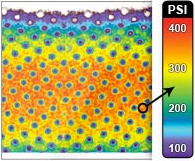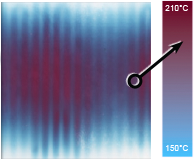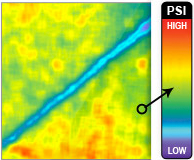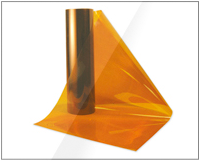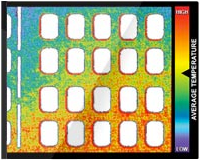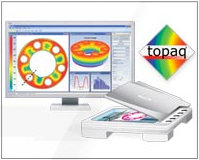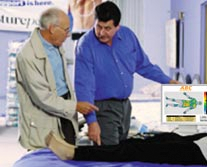Pressure Distribution Measurement of Close Fitting Clothes on Human Body
J. Grepl1, M. Penhaker2, J. Kubicek2, J. Prokop3 and L. Peter2
1 VSB – Technical University Ostrava, Faculty of Mechanical Engineering, Department of Mechanics/IT4Innovations, Ostrava,
Czech Republic
2 VSB – Technical University Ostrava, Faculty of Electrical Engineering and Computer Science, Department of Cybernetics and
Biomedical Engineering, Ostrava, Czech Republic
3 Faculty Hospital, Clinic of Surgery, Ostrava, Czech Republic
Abstract—The article introduces research of non-invasive techniques used for measuring of pressure distribution on human skin by the wearing very tight and close fitting clothes. This fact may lead to significant health complications, because long-term constricting of tissue restricts fluid movement around tissue cells which may cause creation of neoplasm. Especially occurrence of tumour in the women breast is diagnosed with ascending tendency. From these reasons was performed research in the area of possible techniques for noninvasive measurement of forces and corresponding pressures on a human skin. Our goal in this part of research was to find the way to measure the pressure distribution between the clothes and the human skin. Through comparison of the results from different devices, the techniques and their potential application was evaluated for future experiments. In addition, we pointed out the weak points and disadvantages of these measurement methods.
Keywords— tissue, pressure, distribution, measurement.
I. INTRODUCTION
Measuring of soft tissue stiffness is very important nowadays as it may greatly contribute to timely diagnoses of cancer diseases. The cancer is probably the most dreaded human disease. For women, the most frequent threat of this type is the breast cancer. The main reason usually is lack of knowledge, in particular absence of knowledge in terms of the prevention. During the lifetime, nearly 90% of women will have experienced fear when identifying an unnatural solid item in their breast. Fortunately, in most cases this is not the cancer. The cause of the breast cancer is unknown. Nevertheless, there are certain factors which may increase the risk of occurrence of this disease, although any clear connections between these factors and the disease have not been found yet.
Despite the intensive research being done in this field, the breast cancer is spreading very quickly and very globally. Up to the present time, neither prevention nor the cause has been unambiguously identified. The researchers admit that - besides all the verified factors which more or less influence the cancer - there are immensely many other factors still unknown, which calls for a new approach.
Due to the present life style, today's women are exposed to influence of toxins every day. Affected constricted tissues are naturally fighting against the toxins they had been exposed to during the previous day, while new exposure is being added. This is repeated day by day and, after a certain time, the tissue degeneration process may be initiated. Many cycles of toxic influence may result in the cancer – the last stage of tissue degeneration.
II. STATE OF THE ART
At present, there is a range of instruments or devices which are capable to measure the pressure load on human tissues, as well as devices measuring the influence of the clothes on human tissues and changes in tissues caused by wearing certain types of clothes. One of the devices of this type , the " Living body measurement apparatus" described in the existing protected patent US 8328730 B2, includes a display which shows the degree of the pressure the tissue is exposed to. As for the principle, there is a measuring tip which is drawn out, either electronically or mechanically. Along with that, there is another contact area, compensating the pressure acting onto the tissue in the case that the pressure being developed by the apparatus is not constant. [1]
Another system, described in the patent "Instrument for viscoelastic measurement" US 4250894, is used for evaluation of tissue viscoelasticity based on measuring pressure changes between nearby sensors. Due to a precisely defined sensor layout, usually installed on glove fingers, it is assumed that the pressure being developed by the sensors is constant. In general, the palpation method is the most accurate: it is used for examination of the breast tissue very frequently. The examination glove adjusted in this way increases the sensitivity to minor neoplasm, compared to conventional gloves. [2]
The "Medical Device for Diagnosis Pressure Ulcers", protected by the patent US 20130030308 A1, is designed for decubitus diagnostics. The tissue pathologically changed into decubitus changes its viscoelastic properties, thus its optical characteristics, too. The penetration is low, not more than 1cm. Although the device is not used for pressure measurement, it may be useful as an additional modality. [3]
The device described in the patent "Apparatus and method for mechanical imaging of breast", protected with the patent WO 2001082779 A2, is similar to ultrasonic apparatus but does not use the ultrasonic waves. It includes a matrix of pressure sensors, and the signal reflects the pressure change shown by the sensors or detected between two sensors. This method shows higher sensitivity in comparison to conventional palpation examination. [4]
The article "Parameter Measurement of 3D Soft Tissue Model in Warping Simulation" describes a possible 3D representation of the measured tissue, based on pressure measurement by means of a miniature pressure sensor. This measurement method will not be very useful when checking changes in the tissue density or searching for pressure changes in the breast tissue as the miniature sensor on a very thin needle does not offer any control for constant contact pressure. Nevertheless, it is obvious that the pressure changes may be visualised by means of a 3D model. [5]
The device described in the article "Tissue Stiffness From Tactile Imaging", measuring pressure changes in the tissue. Based on such pressure changes, you can identify abnormalities detected in the tissue. The visualisation shows a combination of 2-D screens. The device provides information about the pressure, in particular about the pressure change caused by the tissue; spatial visualisation is not available. [6]
It emerged that abnormalities in the breast tissue can be measured through pressure changes. This theme is widely discussed since we do need to find a suitable examination method to replace the costly elastographic method or mammographic examination. The above-mentioned measurement method using the matrix of pressure sensors seems to be most satisfactory. However, it has not been widely introduced in the clinical practice yet. The use of pressure sensors proves to be very useful as the pressure sensors are more sensitive than any standard palpation examination. By the palpation examination, the physician is able to identify a neoplasm of diameter app. 15mm, while the pressure sensors are able to detect diameters equal to app. 6mm already.
There is no device which would use only 1 pressure sensor, produce pressure curves and visualise them. Such a device would be very useful for quick, cheap and preventive examinations. However, it is necessary to focus on compensation of the pressure applied by the physician as it is not possible to develop a constant pressure when applying the device onto the breast tissue.
It is obvious from the summary that there are certain means to implement such a device. The question is, in which degree something like this would be useful from the medicinal point of view, in terms of the movement of neologisms in the tissue.
III. PROBLEM DEFINITION
The conclusions from the previous research work only refer to a study based on statistic data obtained from two groups of women. It means that there are no supporting physical data or unambiguous evidence from examinations and measurement to demonstrate that the influence of unsuitable or fashion clothes may, in the long run, cause morphological changes in the tissue. In addition, no such scientific conclusions have been presented at scientific conferences or professional journals yet. Thus a certain scope is seen for a precisely focused scientific work which would disprove or confirm this theory.
IV. NEW SOLUTION
In order to verify the theory of possible influence of close fitting clothes upon human tissues, namely in the case of the bra and the breasts, it is necessary to carry out the same type of measurement of pressure distribution repeatedly, on a big target group of women. Such an extensive measurement procedure needs to be precisely specified in terms of the methodology and the technology to be applied during the measurement [7].
There are several techniques which may provide a visual picture of the pressure distribution between the body and the close fitting clothes. However, we need a measuring device which can be applied for any type of clothes, any size or shape, without limitation. Thus the device which would measure the pressure needs to be placed between the close fitting clothes and the human skin. In addition, the device itself must not influence the measurement procedure.
In the case of the measurement of the distribution of the pressure caused by a bra, there are certain limits in terms of the round, two-axis shape of the surface to be measured. Furthermore, it is assumed that the highest measured pressure values will be found along the bra perimeter due to the hard wire which carries and supports the breasts. There is a direct contact with the body and certain permanent pressure as well. Especially on the side, under the shoulder, the sharp end of the supporting wire may act upon the breast tissue with considerable pressure. Another maximum is anticipated directly under the breasts.
Several technologies are available for measuring the pressure between two areas. Firstly, there is artificial or paper film with a special layer which is sensitive to pressure or pressure chemical indication with colour. Secondly, an electronic matrix sensor can be used. This device consists of a matrix of piezo-resistant sensors and a transducer to convert the pressure values into a visualisation.
V. IMPLEMENTATION
In order to select the correct measuring technologic equipment for the planned extensive measurement, several technologies suitable for measuring of the pressure distribution between the clothes and the human body were tested. During the testing, we were working with Pressurex-micro paper pressure-sensitive film; Prescale pressure indicating film; and Tactilus electronic matrix sensor.
To be able to run the test measurement by means of the pressure-sensitive film, first we needed to define the shape of the film to cover the measured points where the maximum pressure was anticipated; the film has to be adjusted to the shape of the bra surface so that the influence of the film on the measurement itself is minimised. For this reason, we decided to use a half-sphere with several cuts to let the film segment adjust better to the surface of the inner side of the bra (Fig- 1).

Fig. 1. The shape of test films
Sets with these cuts were created for both types of the two above-mentioned pressure-sensitive films. In both types of the film, the same principal concept is used - prints of two layers. One layer is covered with dyestuff, which gets in contact with the other layer due to pressure, creating a permanent print. The higher the pressure, the deeper the colour of the print. Subsequently, the prints are scanned and processed by means of special software to produce a colour map which shows the pressure distribution including pressure values.

Fig. 2.The resulting print after the application
The first measurement was run with both types of the shaped film, with only one woman, to be able to compare the results from repeated measurements easily. Films with highest possible sensitivity were used. Two pieces of the test film of the same type were inserted in the bra and their shape was adjusted so that the film fitted to the surface. After that, we removed the cover layer between the pressure- sensitive layers. The bra was put on the body in the standard way, in the effort to create the print under standard circumstances – the person was standing, not moving in any other way, not doing anything else, not exposed to any other load. The resulting print of the Pressurex-micro paper film is shown in Fig. 2.
The print was scanned and converted by means of the software designed for this particular type of the film. However, it was concluded from the follow-up analysis that the pressure between the bra and the breasts was too small since no demonstrable areas with minimum and maximum pressures had emerged. The film was not sensitive enough to the pressure range like this.
![Fig. 3 Tactilus matrix sensor [8]](fig_03.jpg)
Fig. 3 Tactilus matrix sensor [8]
The second test was run with the Tekscan electronic matrix sensor. The device consists of two layers of soft film and pressure sensors installed at precise positions between them. The measured pressure is converted with a transducer and continuously visualised on the PC monitor (Fig. 3).
During the test measurement, this rectangular film designed for measuring of pressure fields on the human body was inserted between the breast and the bra. The bra was fastened as usual. After that, the pressure was measured and recorded. A variety of bras was tested, for example, the standard shape, push-up, sport bra etc. Some of them were acting on the body more intensively than the bra designed for normal everyday use. However, no significant measurable and recordable results were achieved.
There are several reasons why this measurement method has not produced anticipated results. The large range 1- 100KPa as well as the low sensitivity had caused only minor changes of the pressures measured at the measurement points exposed to the pressure more or less – at the level of approx. 1KPa. The sensors integrated in this electronic device were able to measure accurate values of the pressure only if the pressure was applied perpendicularly to the sensor level. Considering the purpose, the measurement of the pressure developed by the bra, this is a major technical issue. The breast tissue is pushed by the bra and shifted upwards in the vertical direction. Along with that, the natural shape of the breasts is changed and this change is not even in all directions. Furthermore, the film which protects the sensors is not suitable for this purpose since the sensor cannot be adjusted to the surface of the breast and the bra without unavoidable folds of the sensor area. The rigidity of the cover and supporting films at the sensor measuring area is another issue; in this particular case, the high rigidity makes the accurate pressure measurement in many different directions impossible.
VI. CONCLUSIONS
It was found out through the real test of three different systems measuring the pressure distributions between two surfaces that these technologies are not suitable for examination of the pressure developed by the bra and acting on the human body.
The materials and the technologies used for the design and construction of these systems do not allow using them for this measurement purpose. The high rigidity of the materials used for their construction makes adjustment of the sensor to the curved surface of the breast and the bra impossible.
These systems cannot be used for the verification of the theory of the influence of close fitting clothes on human health. As it is impossible to use these - only available - systems, the planned extensive test could not be run.
Up to the present time, we have not been able to test the latest developed Tactilus stretch sensor. In this device, a similar concept is used as in the above-mentioned Tekscan matrix sensor, which we had tried out. Unlike the Tekscan with the film, an elastic textile material is used in the Tactilus. Such textile may adjust to the curved surface perfectly and, provided that a correct measurement range and correct sensitivity is used, this would be a suitable alternative in order to achieve significant measurement results and verify the theory.
ACKNOWLEDGMENT
The work and the contributions were supported by the project SP2013/35 “Biomedical engineering systems IX” and TACR TA01010632 “SCADA system for control and measurement of the process in real time”. The paper has been written within the framework of the IT4 Innovations Centre of Excellence project, reg. no. CZ.1.05/1.1.00/02.0070 supported by the Operational Programme 'Research and Development for Innovations' funded by Structural Funds of the European Union and the state budget of the Czech Republic.
REFERENCES
- Living body measurement apparatus [online] (2007) In https://www.google.com/patents/US8328730
- Apparatus and method for mechanical imaging of breast [online] (1999) In http://www.google.com/patents/US5860934
- Method and device for mechanical imaging of breast [online] (1992) In http://www.google.com/patents/US20130030308
- Medical Device for Diagnosis Pressure Ulcers [online] (2007) In https://www.google.com/patents/WO2001082779A2
- Parameter Measurement of 3D Soft Tissue Model in Warping Simulation [online] (2012) In http://ieeexplore.ieee.org/xpl/articleDetails.jsp?tp=&arnumber=6223216
- Development of a Micromachined Pressure Transducer for Biomedical Device Tissue Interfaces [online] (1996) In http://ieeexplore.ieee.org/xpl/articleDetails.jsp?tp=&arnumber=548046
- Kristof, M., [a kol.]: Contact pressure measurement in trunk orthoses, ICCC - CONTI (2010), IEEE International Joint Conferences on Computational Cybernetics and Technical Informatics, May 27-29, ISBN 978-1-4244-7431-8 .
- SPI Sensor Product Inc. [online] 2013 [cit. 20.08.2013] http://www.sensorprod.com/tactilus.php
Author: Jan Grepl
Institute: VSB - Technical University of Ostrava
Street: 17. listopadu 15
City: Ostrava
Country: Czech Republic
Email: [email protected]




